Developing a Sustainable Corporate Strategy for Gap Inc. (MGMT6016)
VerifiedAdded on 2023/01/18
|18
|4377
|70
Report
AI Summary
This report provides a comprehensive analysis of Gap Inc.'s sustainable corporate strategy, examining its current strategic position, reporting practices, and proposing a new strategy based on the triple bottom line approach. The report begins with an introduction to the global context of sustainability and the importance of sustainable prosperity. It then explores Gap's current strategic sustainability position, including its human rights policy, climate change initiatives, and core focus areas such as advancing people and communities, improving supply chain working conditions, water sustainability management, eco-efficiency operations, and product sustainability. A critical evaluation of Gap's sustainability reporting issues is also provided. Finally, the report proposes a sustainability strategy for Gap, emphasizing the triple bottom line approach, which considers social, environmental, and economic factors. The report concludes with recommendations for Gap to enhance its sustainability efforts and gain a competitive advantage in the global market. The analysis considers the company's compliance with laws, its management approach, and its efforts to minimize its environmental footprint.
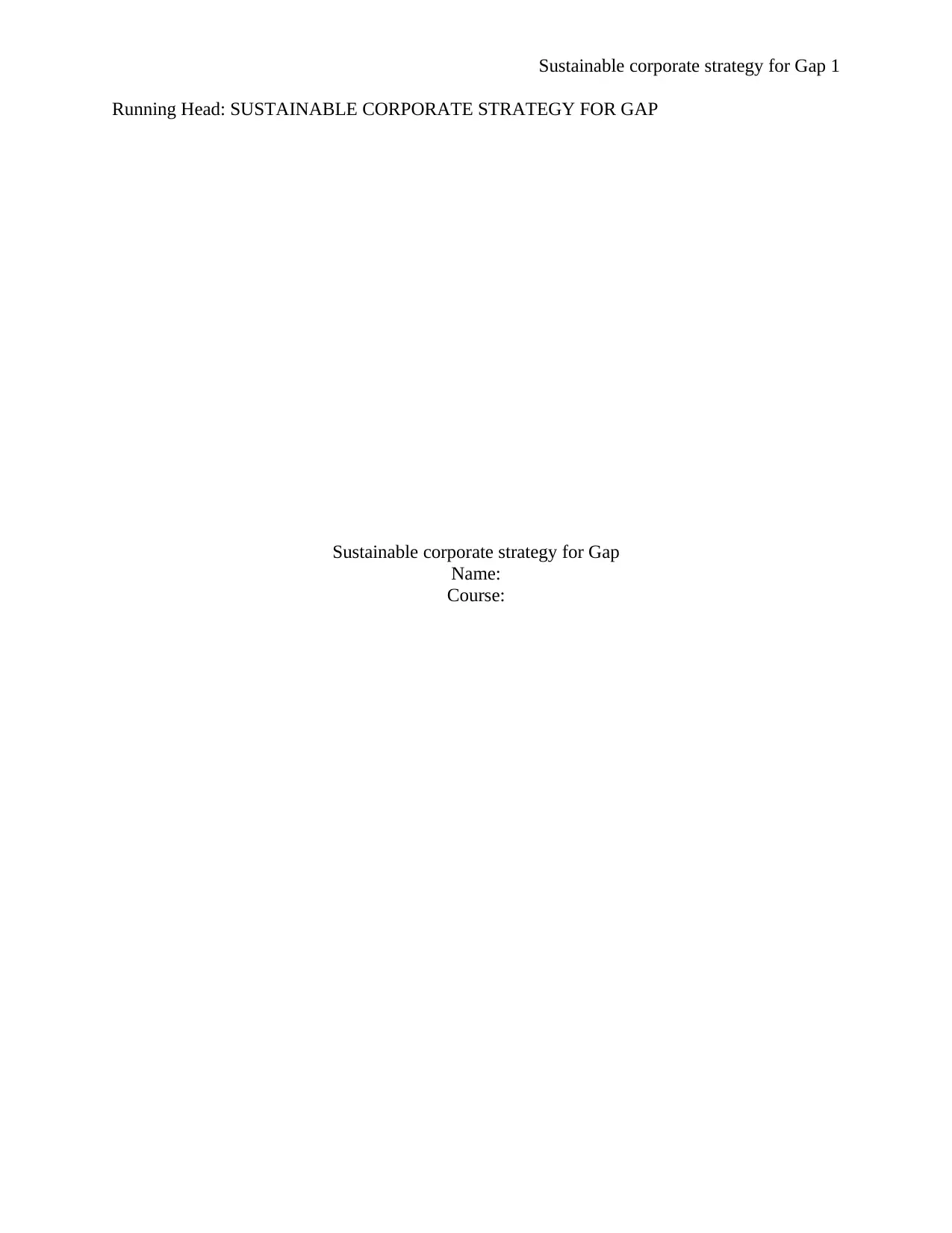
1Sustainable corporate strategy for Gap
Running Head: SUSTAINABLE CORPORATE STRATEGY FOR GAP
Sustainable corporate strategy for Gap
Name:
Course:
Running Head: SUSTAINABLE CORPORATE STRATEGY FOR GAP
Sustainable corporate strategy for Gap
Name:
Course:
Paraphrase This Document
Need a fresh take? Get an instant paraphrase of this document with our AI Paraphraser
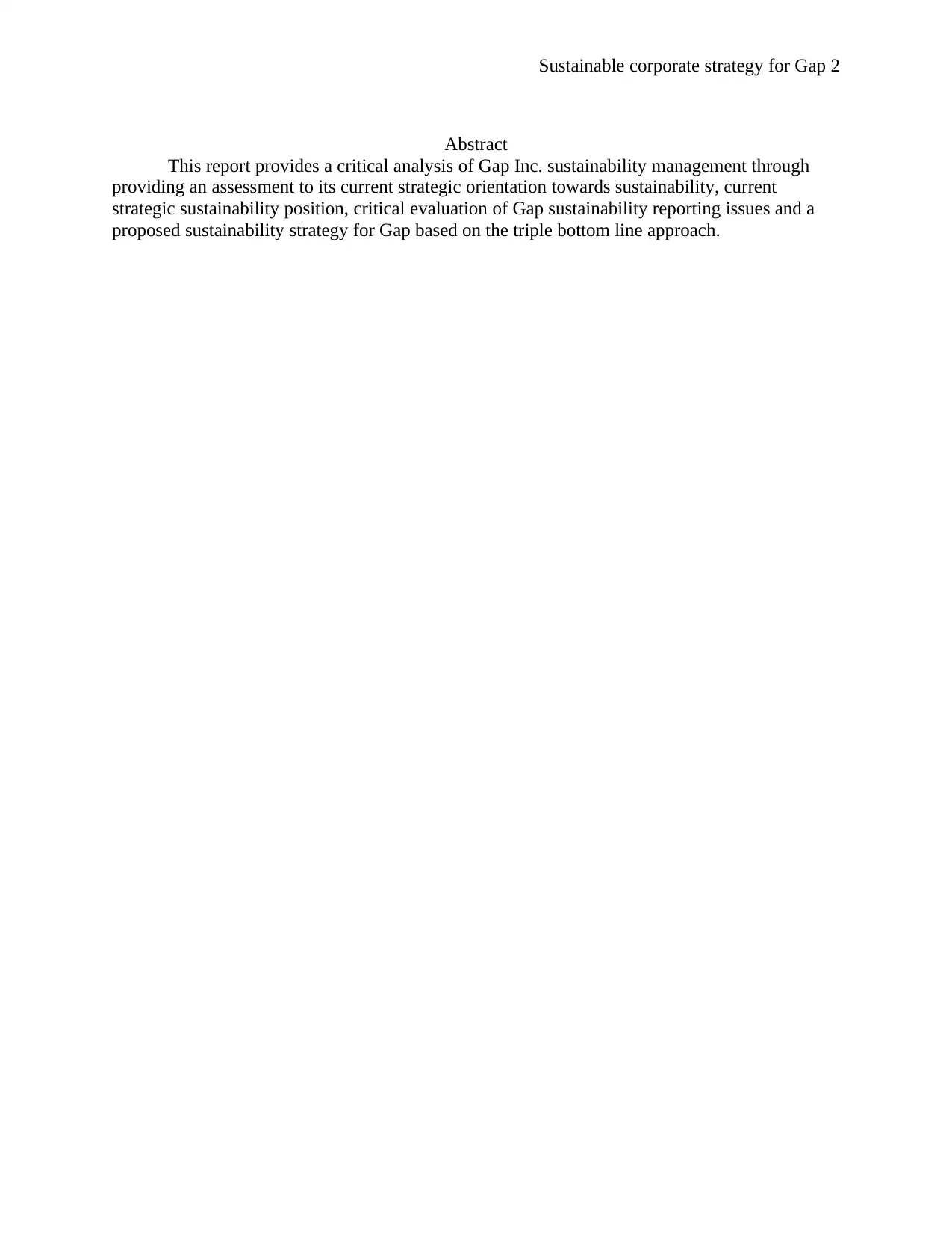
2Sustainable corporate strategy for Gap
Abstract
This report provides a critical analysis of Gap Inc. sustainability management through
providing an assessment to its current strategic orientation towards sustainability, current
strategic sustainability position, critical evaluation of Gap sustainability reporting issues and a
proposed sustainability strategy for Gap based on the triple bottom line approach.
Abstract
This report provides a critical analysis of Gap Inc. sustainability management through
providing an assessment to its current strategic orientation towards sustainability, current
strategic sustainability position, critical evaluation of Gap sustainability reporting issues and a
proposed sustainability strategy for Gap based on the triple bottom line approach.
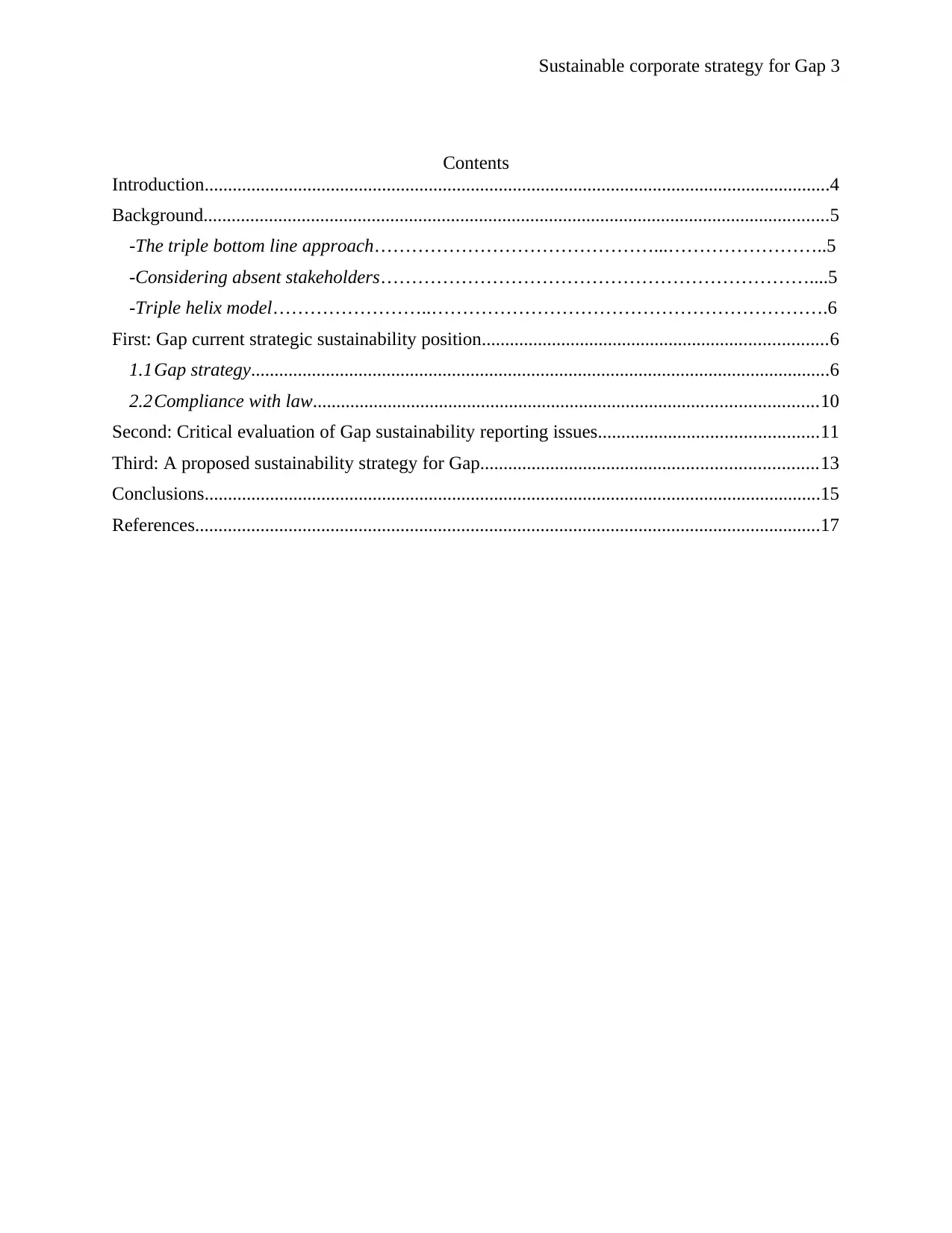
3Sustainable corporate strategy for Gap
Contents
Introduction......................................................................................................................................4
Background......................................................................................................................................5
-The triple bottom line approach………………………………………...……………………..5
-Considering absent stakeholders……………………………………………………………....5
-Triple helix model……………………..……………………………………………………….6
First: Gap current strategic sustainability position..........................................................................6
1.1Gap strategy............................................................................................................................6
2.2Compliance with law............................................................................................................10
Second: Critical evaluation of Gap sustainability reporting issues...............................................11
Third: A proposed sustainability strategy for Gap........................................................................13
Conclusions....................................................................................................................................15
References......................................................................................................................................17
Contents
Introduction......................................................................................................................................4
Background......................................................................................................................................5
-The triple bottom line approach………………………………………...……………………..5
-Considering absent stakeholders……………………………………………………………....5
-Triple helix model……………………..……………………………………………………….6
First: Gap current strategic sustainability position..........................................................................6
1.1Gap strategy............................................................................................................................6
2.2Compliance with law............................................................................................................10
Second: Critical evaluation of Gap sustainability reporting issues...............................................11
Third: A proposed sustainability strategy for Gap........................................................................13
Conclusions....................................................................................................................................15
References......................................................................................................................................17
⊘ This is a preview!⊘
Do you want full access?
Subscribe today to unlock all pages.

Trusted by 1+ million students worldwide
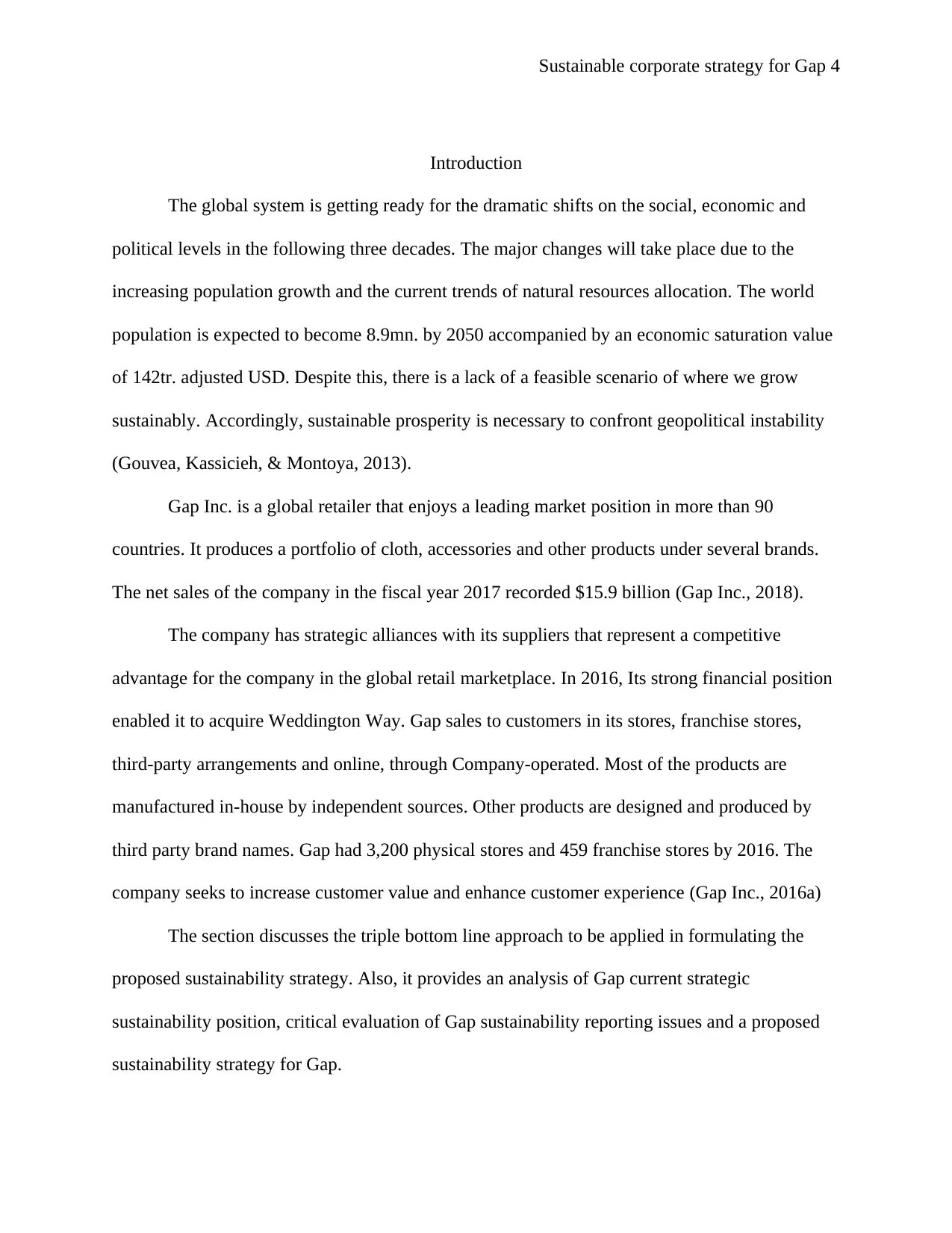
4Sustainable corporate strategy for Gap
Introduction
The global system is getting ready for the dramatic shifts on the social, economic and
political levels in the following three decades. The major changes will take place due to the
increasing population growth and the current trends of natural resources allocation. The world
population is expected to become 8.9mn. by 2050 accompanied by an economic saturation value
of 142tr. adjusted USD. Despite this, there is a lack of a feasible scenario of where we grow
sustainably. Accordingly, sustainable prosperity is necessary to confront geopolitical instability
(Gouvea, Kassicieh, & Montoya, 2013).
Gap Inc. is a global retailer that enjoys a leading market position in more than 90
countries. It produces a portfolio of cloth, accessories and other products under several brands.
The net sales of the company in the fiscal year 2017 recorded $15.9 billion (Gap Inc., 2018).
The company has strategic alliances with its suppliers that represent a competitive
advantage for the company in the global retail marketplace. In 2016, Its strong financial position
enabled it to acquire Weddington Way. Gap sales to customers in its stores, franchise stores,
third-party arrangements and online, through Company-operated. Most of the products are
manufactured in-house by independent sources. Other products are designed and produced by
third party brand names. Gap had 3,200 physical stores and 459 franchise stores by 2016. The
company seeks to increase customer value and enhance customer experience (Gap Inc., 2016a)
The section discusses the triple bottom line approach to be applied in formulating the
proposed sustainability strategy. Also, it provides an analysis of Gap current strategic
sustainability position, critical evaluation of Gap sustainability reporting issues and a proposed
sustainability strategy for Gap.
Introduction
The global system is getting ready for the dramatic shifts on the social, economic and
political levels in the following three decades. The major changes will take place due to the
increasing population growth and the current trends of natural resources allocation. The world
population is expected to become 8.9mn. by 2050 accompanied by an economic saturation value
of 142tr. adjusted USD. Despite this, there is a lack of a feasible scenario of where we grow
sustainably. Accordingly, sustainable prosperity is necessary to confront geopolitical instability
(Gouvea, Kassicieh, & Montoya, 2013).
Gap Inc. is a global retailer that enjoys a leading market position in more than 90
countries. It produces a portfolio of cloth, accessories and other products under several brands.
The net sales of the company in the fiscal year 2017 recorded $15.9 billion (Gap Inc., 2018).
The company has strategic alliances with its suppliers that represent a competitive
advantage for the company in the global retail marketplace. In 2016, Its strong financial position
enabled it to acquire Weddington Way. Gap sales to customers in its stores, franchise stores,
third-party arrangements and online, through Company-operated. Most of the products are
manufactured in-house by independent sources. Other products are designed and produced by
third party brand names. Gap had 3,200 physical stores and 459 franchise stores by 2016. The
company seeks to increase customer value and enhance customer experience (Gap Inc., 2016a)
The section discusses the triple bottom line approach to be applied in formulating the
proposed sustainability strategy. Also, it provides an analysis of Gap current strategic
sustainability position, critical evaluation of Gap sustainability reporting issues and a proposed
sustainability strategy for Gap.
Paraphrase This Document
Need a fresh take? Get an instant paraphrase of this document with our AI Paraphraser

5Sustainable corporate strategy for Gap
Background
The triple bottom line approach
Organizational competitiveness is globally investigated in order to expand its definition.
The global movement considers organizational performance factors other than the financial
indicators. Their concern is growing towards the environmental impact of doing business
activities. The triple bottom line approach reflects the growing concern of organizations'
footprint on the environment in which they operate. Over time, an increasing number of
organizations are reporting triple bottom line performance indicators on an annual basis. The
movement towards the quadruple bottom line approach requires differentiation between the
firm's effect on their employees as well as communities located around their manufacturing
facilities (Lawler, 2014).
Other researchers consider the impact on the environment through the community
perspective that devotes attention to the relationships between the organization and the
community, which is called the external impact perspective. Also, it considers the organizations
complex, open and adaptive nature in their social, natural and cultural environments (Hadders,
2011).
Considering absent stakeholders
Another perspective that could be considered is adding the stakeholders to create a new
dimension to the triple bottom line because they might be affected in the future. The absent
stakeholders could include individuals, organizations and communities that might be positively
or negatively affected in the future by the current business practices. This issue was first
mentioned in the theory of Justice, it assumes that the best way to implement general principles
is to place each person in a position rather than to ignore them. People should know their role in
Background
The triple bottom line approach
Organizational competitiveness is globally investigated in order to expand its definition.
The global movement considers organizational performance factors other than the financial
indicators. Their concern is growing towards the environmental impact of doing business
activities. The triple bottom line approach reflects the growing concern of organizations'
footprint on the environment in which they operate. Over time, an increasing number of
organizations are reporting triple bottom line performance indicators on an annual basis. The
movement towards the quadruple bottom line approach requires differentiation between the
firm's effect on their employees as well as communities located around their manufacturing
facilities (Lawler, 2014).
Other researchers consider the impact on the environment through the community
perspective that devotes attention to the relationships between the organization and the
community, which is called the external impact perspective. Also, it considers the organizations
complex, open and adaptive nature in their social, natural and cultural environments (Hadders,
2011).
Considering absent stakeholders
Another perspective that could be considered is adding the stakeholders to create a new
dimension to the triple bottom line because they might be affected in the future. The absent
stakeholders could include individuals, organizations and communities that might be positively
or negatively affected in the future by the current business practices. This issue was first
mentioned in the theory of Justice, it assumes that the best way to implement general principles
is to place each person in a position rather than to ignore them. People should know their role in
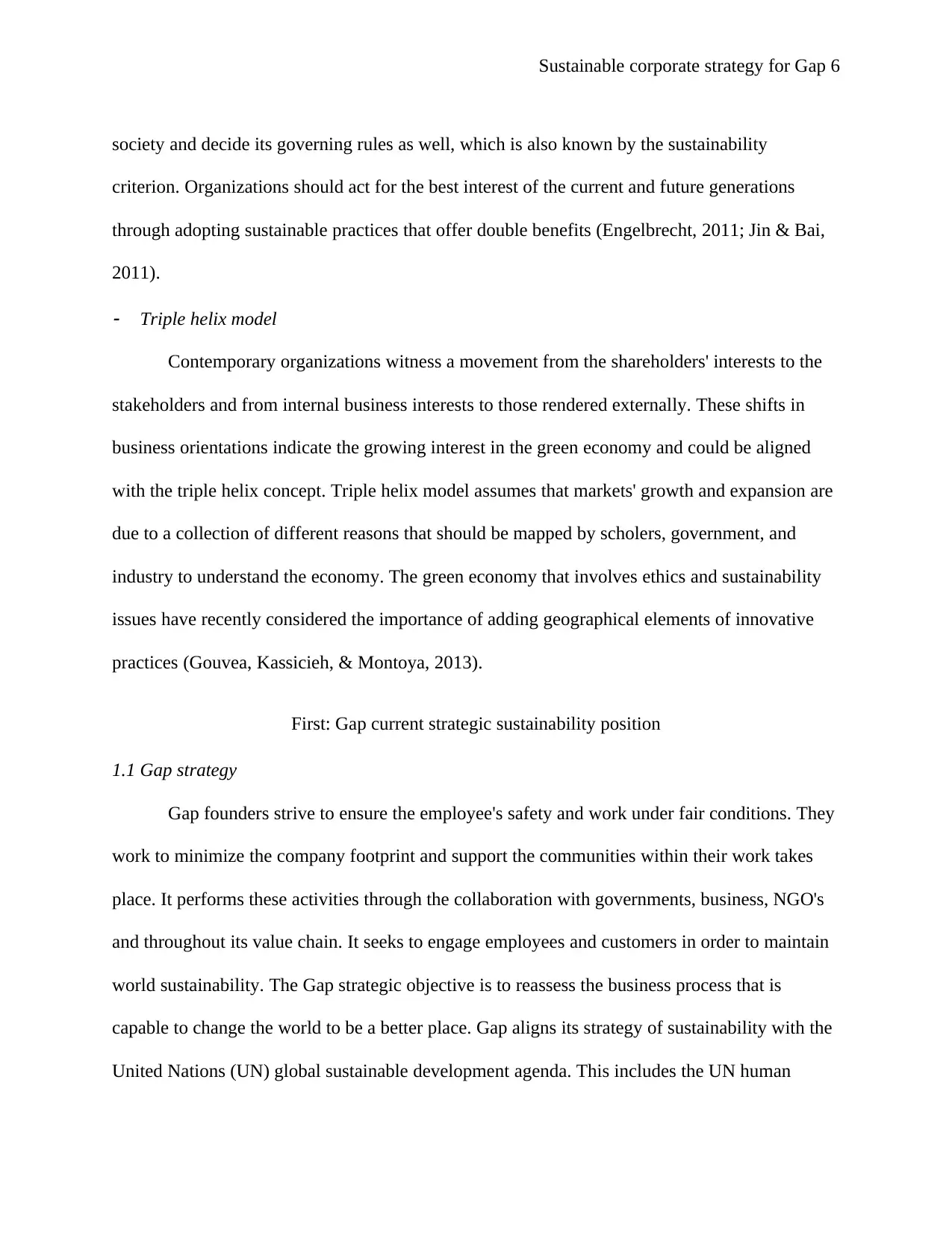
6Sustainable corporate strategy for Gap
society and decide its governing rules as well, which is also known by the sustainability
criterion. Organizations should act for the best interest of the current and future generations
through adopting sustainable practices that offer double benefits (Engelbrecht, 2011; Jin & Bai,
2011).
Triple helix model
Contemporary organizations witness a movement from the shareholders' interests to the
stakeholders and from internal business interests to those rendered externally. These shifts in
business orientations indicate the growing interest in the green economy and could be aligned
with the triple helix concept. Triple helix model assumes that markets' growth and expansion are
due to a collection of different reasons that should be mapped by scholers, government, and
industry to understand the economy. The green economy that involves ethics and sustainability
issues have recently considered the importance of adding geographical elements of innovative
practices (Gouvea, Kassicieh, & Montoya, 2013).
First: Gap current strategic sustainability position
1.1 Gap strategy
Gap founders strive to ensure the employee's safety and work under fair conditions. They
work to minimize the company footprint and support the communities within their work takes
place. It performs these activities through the collaboration with governments, business, NGO's
and throughout its value chain. It seeks to engage employees and customers in order to maintain
world sustainability. The Gap strategic objective is to reassess the business process that is
capable to change the world to be a better place. Gap aligns its strategy of sustainability with the
United Nations (UN) global sustainable development agenda. This includes the UN human
society and decide its governing rules as well, which is also known by the sustainability
criterion. Organizations should act for the best interest of the current and future generations
through adopting sustainable practices that offer double benefits (Engelbrecht, 2011; Jin & Bai,
2011).
Triple helix model
Contemporary organizations witness a movement from the shareholders' interests to the
stakeholders and from internal business interests to those rendered externally. These shifts in
business orientations indicate the growing interest in the green economy and could be aligned
with the triple helix concept. Triple helix model assumes that markets' growth and expansion are
due to a collection of different reasons that should be mapped by scholers, government, and
industry to understand the economy. The green economy that involves ethics and sustainability
issues have recently considered the importance of adding geographical elements of innovative
practices (Gouvea, Kassicieh, & Montoya, 2013).
First: Gap current strategic sustainability position
1.1 Gap strategy
Gap founders strive to ensure the employee's safety and work under fair conditions. They
work to minimize the company footprint and support the communities within their work takes
place. It performs these activities through the collaboration with governments, business, NGO's
and throughout its value chain. It seeks to engage employees and customers in order to maintain
world sustainability. The Gap strategic objective is to reassess the business process that is
capable to change the world to be a better place. Gap aligns its strategy of sustainability with the
United Nations (UN) global sustainable development agenda. This includes the UN human
⊘ This is a preview!⊘
Do you want full access?
Subscribe today to unlock all pages.

Trusted by 1+ million students worldwide

7Sustainable corporate strategy for Gap
rights, Sustainable Development Goals (SDGs) and the Paris Agreement on climate change.
These positive actions have laid the basis of business value compliance with the environment and
society. Gap considers the global agenda to its own agenda that guides its sustainable business in
a way that maximizes its impact. The gap sustainability strategy is analyzed according to Gap
Inc. (2019b), as follows:
Gap human rights policy: This policy depends on providing good treatment and protection of
the human rights in the light of UN Guiding Principles to about 135 thousand employees and
numerous number of people engaged in the company supply chain activities. It ensures that all
of its employees and partners work under safe and fair conditions and that they are well
managed with respect and dignity.
Addressing the global climate: Gap recognizes the necessity of addressing the global climate
change resulted from greenhouse gas emissions and other harmful impacts that occurred due to
the company value chain activities. Also, it stresses on reporting about a healthy planet by
adding its voice and providing support to the 'We Mean Business coalition'. It is highly
committed to taking leadership on climate action that complements its efforts in protecting the
world's water resources. Also, GAP continuously reviews its progress on the SDGs and ensure
that its goals are aligned with them.
Gap core sustainability focus areas: Gap Inc. sustainability helped in establishing 5 core focus
areas, as follows:
Advancing people and communities: Gap aims to give the opportunity to people with
exceptional efforts to the development of its businesses, including employees at stores,
employees in suppliers' locations and resident population around its sites.
rights, Sustainable Development Goals (SDGs) and the Paris Agreement on climate change.
These positive actions have laid the basis of business value compliance with the environment and
society. Gap considers the global agenda to its own agenda that guides its sustainable business in
a way that maximizes its impact. The gap sustainability strategy is analyzed according to Gap
Inc. (2019b), as follows:
Gap human rights policy: This policy depends on providing good treatment and protection of
the human rights in the light of UN Guiding Principles to about 135 thousand employees and
numerous number of people engaged in the company supply chain activities. It ensures that all
of its employees and partners work under safe and fair conditions and that they are well
managed with respect and dignity.
Addressing the global climate: Gap recognizes the necessity of addressing the global climate
change resulted from greenhouse gas emissions and other harmful impacts that occurred due to
the company value chain activities. Also, it stresses on reporting about a healthy planet by
adding its voice and providing support to the 'We Mean Business coalition'. It is highly
committed to taking leadership on climate action that complements its efforts in protecting the
world's water resources. Also, GAP continuously reviews its progress on the SDGs and ensure
that its goals are aligned with them.
Gap core sustainability focus areas: Gap Inc. sustainability helped in establishing 5 core focus
areas, as follows:
Advancing people and communities: Gap aims to give the opportunity to people with
exceptional efforts to the development of its businesses, including employees at stores,
employees in suppliers' locations and resident population around its sites.
Paraphrase This Document
Need a fresh take? Get an instant paraphrase of this document with our AI Paraphraser

8Sustainable corporate strategy for Gap
Improving supply chain working conditions: This area considers making partnerships with
suppliers and providing healthy, productive and secure work environemnt for the staff. Gap
builds its suppliers' capabilities in order to impact their practices effectively to improve
workers and managers relations and increase transparency.
Water sustainability management: Water is essential to Gap business, people and
communities in which it operates. It addresses the quantity of water throughout its value
chain and across different societies.
Eco-efficiency operations: Gap manages to reduce its greenhouse gas emissions and eliminate
its waste. It works with its partners in logistics and procurement for improving operations
efficiency and enhancing the environmental impact.
Sustainability of products: Gap works with the designers to coordinate the customers' needs of
obtaining value products and at the same time reducing their environmental impact.
Gap management approach: Considering the big size of the company, Gap feels highly
responsible for the planet and people working in apparel manufacturing. The global scale of the
company offers a good opportunity to create a difference. Gap plans to achieve its aim of
reimagining the way business is able to change the world by adopting long-term performance
strategy and at the same time delivering high-quality products, implementing innovations on
the social and environmental scales that enable workers to achieve their desired goals and scale
innovations through developing integrated business and products.
Gap also follows its own international approach in implementing its social and environmental
programs, they are analyzed according to Gap Inc. (2019b), as follows:
Improving supply chain working conditions: This area considers making partnerships with
suppliers and providing healthy, productive and secure work environemnt for the staff. Gap
builds its suppliers' capabilities in order to impact their practices effectively to improve
workers and managers relations and increase transparency.
Water sustainability management: Water is essential to Gap business, people and
communities in which it operates. It addresses the quantity of water throughout its value
chain and across different societies.
Eco-efficiency operations: Gap manages to reduce its greenhouse gas emissions and eliminate
its waste. It works with its partners in logistics and procurement for improving operations
efficiency and enhancing the environmental impact.
Sustainability of products: Gap works with the designers to coordinate the customers' needs of
obtaining value products and at the same time reducing their environmental impact.
Gap management approach: Considering the big size of the company, Gap feels highly
responsible for the planet and people working in apparel manufacturing. The global scale of the
company offers a good opportunity to create a difference. Gap plans to achieve its aim of
reimagining the way business is able to change the world by adopting long-term performance
strategy and at the same time delivering high-quality products, implementing innovations on
the social and environmental scales that enable workers to achieve their desired goals and scale
innovations through developing integrated business and products.
Gap also follows its own international approach in implementing its social and environmental
programs, they are analyzed according to Gap Inc. (2019b), as follows:

9Sustainable corporate strategy for Gap
Sustainability and business integration: Gap creates high accountability for its strategy of
sustainability by developing and communicating common sustainability goals that spans
within the entire company.
Setting ambitious goals: Gap focuses on major sustainability indicators of its business to be
able to measure its sustainable performance progress on real benefits delivery to the
customers and societies.
To progress toward its commitments: Gap meaningfully contributes to people and places
involved in its business that help the company to succeed.
Increasing the collective impact: Gap adopts the policy of partnering with organizations
across the local and global levels to achieve long term sustainable progress.
Gap seeks to minimize its footprint throughout its direct operations and its broader supply
chain. This target is achievable according to Gap Inc, (2019c), by adopting the following
approaches:
Creating solutions for women and water: Gap strategy focuses on the balancing between its
actual use of water and people's principle right of accessing water. The manufacturing supply
chain is connected with many women and their communities that gives the companheir
societies through its P.A.C.E. program through partnerships, with global international agencies,
like the USAID.
Improving manufacturing at mills and laundries: The manufacturing process of clothing
affects the environment and people. Traditional fabric mills used to consume a great deal of
water and chemicals. Wastewater should be effectively treated to protect the sustainability of
the ecosystems and communities surrounding the factories. Laundries are heavy reliant on
Sustainability and business integration: Gap creates high accountability for its strategy of
sustainability by developing and communicating common sustainability goals that spans
within the entire company.
Setting ambitious goals: Gap focuses on major sustainability indicators of its business to be
able to measure its sustainable performance progress on real benefits delivery to the
customers and societies.
To progress toward its commitments: Gap meaningfully contributes to people and places
involved in its business that help the company to succeed.
Increasing the collective impact: Gap adopts the policy of partnering with organizations
across the local and global levels to achieve long term sustainable progress.
Gap seeks to minimize its footprint throughout its direct operations and its broader supply
chain. This target is achievable according to Gap Inc, (2019c), by adopting the following
approaches:
Creating solutions for women and water: Gap strategy focuses on the balancing between its
actual use of water and people's principle right of accessing water. The manufacturing supply
chain is connected with many women and their communities that gives the companheir
societies through its P.A.C.E. program through partnerships, with global international agencies,
like the USAID.
Improving manufacturing at mills and laundries: The manufacturing process of clothing
affects the environment and people. Traditional fabric mills used to consume a great deal of
water and chemicals. Wastewater should be effectively treated to protect the sustainability of
the ecosystems and communities surrounding the factories. Laundries are heavy reliant on
⊘ This is a preview!⊘
Do you want full access?
Subscribe today to unlock all pages.

Trusted by 1+ million students worldwide
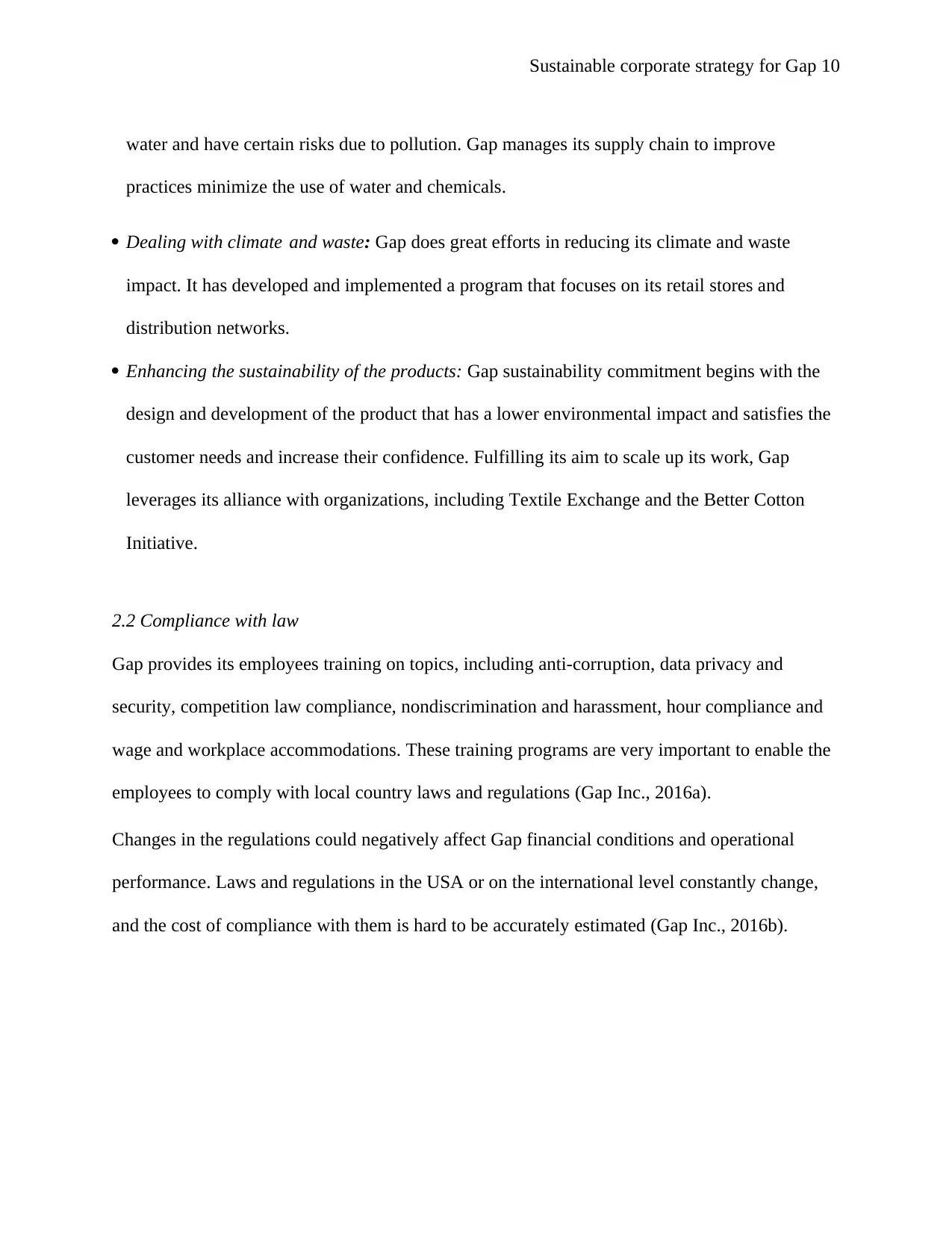
10Sustainable corporate strategy for Gap
water and have certain risks due to pollution. Gap manages its supply chain to improve
practices minimize the use of water and chemicals.
Dealing with climate and waste: Gap does great efforts in reducing its climate and waste
impact. It has developed and implemented a program that focuses on its retail stores and
distribution networks.
Enhancing the sustainability of the products: Gap sustainability commitment begins with the
design and development of the product that has a lower environmental impact and satisfies the
customer needs and increase their confidence. Fulfilling its aim to scale up its work, Gap
leverages its alliance with organizations, including Textile Exchange and the Better Cotton
Initiative.
2.2 Compliance with law
Gap provides its employees training on topics, including anti-corruption, data privacy and
security, competition law compliance, nondiscrimination and harassment, hour compliance and
wage and workplace accommodations. These training programs are very important to enable the
employees to comply with local country laws and regulations (Gap Inc., 2016a).
Changes in the regulations could negatively affect Gap financial conditions and operational
performance. Laws and regulations in the USA or on the international level constantly change,
and the cost of compliance with them is hard to be accurately estimated (Gap Inc., 2016b).
water and have certain risks due to pollution. Gap manages its supply chain to improve
practices minimize the use of water and chemicals.
Dealing with climate and waste: Gap does great efforts in reducing its climate and waste
impact. It has developed and implemented a program that focuses on its retail stores and
distribution networks.
Enhancing the sustainability of the products: Gap sustainability commitment begins with the
design and development of the product that has a lower environmental impact and satisfies the
customer needs and increase their confidence. Fulfilling its aim to scale up its work, Gap
leverages its alliance with organizations, including Textile Exchange and the Better Cotton
Initiative.
2.2 Compliance with law
Gap provides its employees training on topics, including anti-corruption, data privacy and
security, competition law compliance, nondiscrimination and harassment, hour compliance and
wage and workplace accommodations. These training programs are very important to enable the
employees to comply with local country laws and regulations (Gap Inc., 2016a).
Changes in the regulations could negatively affect Gap financial conditions and operational
performance. Laws and regulations in the USA or on the international level constantly change,
and the cost of compliance with them is hard to be accurately estimated (Gap Inc., 2016b).
Paraphrase This Document
Need a fresh take? Get an instant paraphrase of this document with our AI Paraphraser
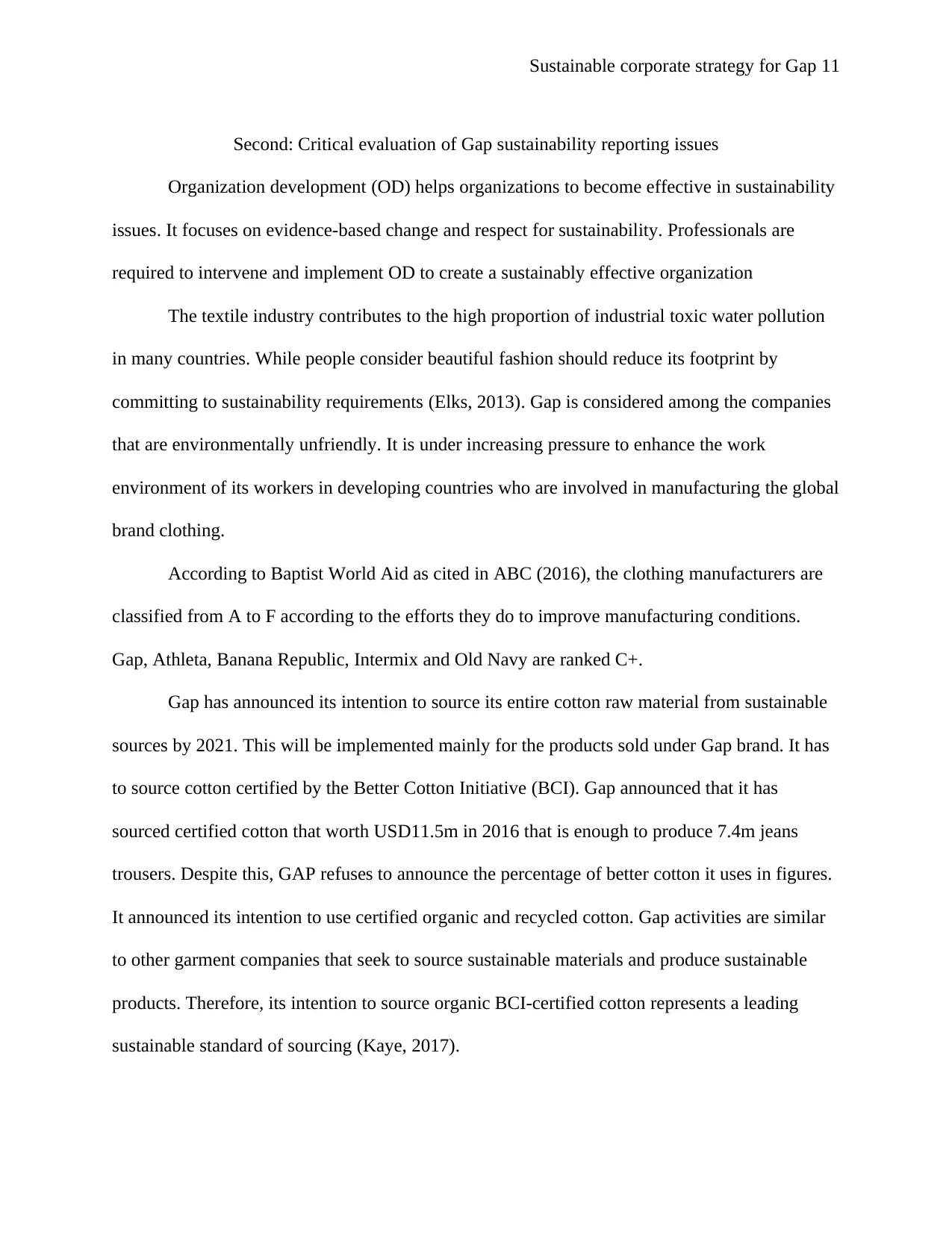
11Sustainable corporate strategy for Gap
Second: Critical evaluation of Gap sustainability reporting issues
Organization development (OD) helps organizations to become effective in sustainability
issues. It focuses on evidence-based change and respect for sustainability. Professionals are
required to intervene and implement OD to create a sustainably effective organization
The textile industry contributes to the high proportion of industrial toxic water pollution
in many countries. While people consider beautiful fashion should reduce its footprint by
committing to sustainability requirements (Elks, 2013). Gap is considered among the companies
that are environmentally unfriendly. It is under increasing pressure to enhance the work
environment of its workers in developing countries who are involved in manufacturing the global
brand clothing.
According to Baptist World Aid as cited in ABC (2016), the clothing manufacturers are
classified from A to F according to the efforts they do to improve manufacturing conditions.
Gap, Athleta, Banana Republic, Intermix and Old Navy are ranked C+.
Gap has announced its intention to source its entire cotton raw material from sustainable
sources by 2021. This will be implemented mainly for the products sold under Gap brand. It has
to source cotton certified by the Better Cotton Initiative (BCI). Gap announced that it has
sourced certified cotton that worth USD11.5m in 2016 that is enough to produce 7.4m jeans
trousers. Despite this, GAP refuses to announce the percentage of better cotton it uses in figures.
It announced its intention to use certified organic and recycled cotton. Gap activities are similar
to other garment companies that seek to source sustainable materials and produce sustainable
products. Therefore, its intention to source organic BCI-certified cotton represents a leading
sustainable standard of sourcing (Kaye, 2017).
Second: Critical evaluation of Gap sustainability reporting issues
Organization development (OD) helps organizations to become effective in sustainability
issues. It focuses on evidence-based change and respect for sustainability. Professionals are
required to intervene and implement OD to create a sustainably effective organization
The textile industry contributes to the high proportion of industrial toxic water pollution
in many countries. While people consider beautiful fashion should reduce its footprint by
committing to sustainability requirements (Elks, 2013). Gap is considered among the companies
that are environmentally unfriendly. It is under increasing pressure to enhance the work
environment of its workers in developing countries who are involved in manufacturing the global
brand clothing.
According to Baptist World Aid as cited in ABC (2016), the clothing manufacturers are
classified from A to F according to the efforts they do to improve manufacturing conditions.
Gap, Athleta, Banana Republic, Intermix and Old Navy are ranked C+.
Gap has announced its intention to source its entire cotton raw material from sustainable
sources by 2021. This will be implemented mainly for the products sold under Gap brand. It has
to source cotton certified by the Better Cotton Initiative (BCI). Gap announced that it has
sourced certified cotton that worth USD11.5m in 2016 that is enough to produce 7.4m jeans
trousers. Despite this, GAP refuses to announce the percentage of better cotton it uses in figures.
It announced its intention to use certified organic and recycled cotton. Gap activities are similar
to other garment companies that seek to source sustainable materials and produce sustainable
products. Therefore, its intention to source organic BCI-certified cotton represents a leading
sustainable standard of sourcing (Kaye, 2017).
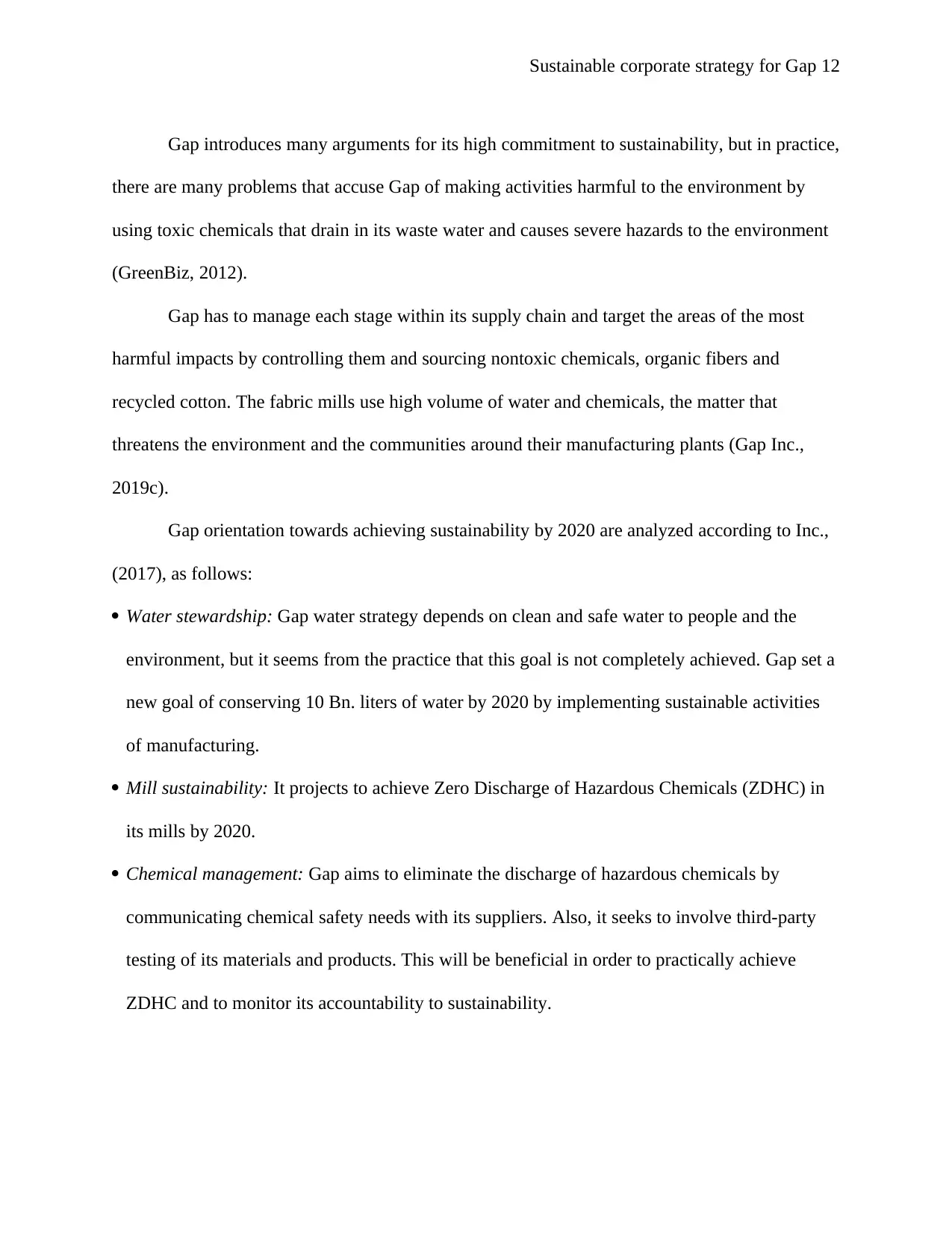
12Sustainable corporate strategy for Gap
Gap introduces many arguments for its high commitment to sustainability, but in practice,
there are many problems that accuse Gap of making activities harmful to the environment by
using toxic chemicals that drain in its waste water and causes severe hazards to the environment
(GreenBiz, 2012).
Gap has to manage each stage within its supply chain and target the areas of the most
harmful impacts by controlling them and sourcing nontoxic chemicals, organic fibers and
recycled cotton. The fabric mills use high volume of water and chemicals, the matter that
threatens the environment and the communities around their manufacturing plants (Gap Inc.,
2019c).
Gap orientation towards achieving sustainability by 2020 are analyzed according to Inc.,
(2017), as follows:
Water stewardship: Gap water strategy depends on clean and safe water to people and the
environment, but it seems from the practice that this goal is not completely achieved. Gap set a
new goal of conserving 10 Bn. liters of water by 2020 by implementing sustainable activities
of manufacturing.
Mill sustainability: It projects to achieve Zero Discharge of Hazardous Chemicals (ZDHC) in
its mills by 2020.
Chemical management: Gap aims to eliminate the discharge of hazardous chemicals by
communicating chemical safety needs with its suppliers. Also, it seeks to involve third-party
testing of its materials and products. This will be beneficial in order to practically achieve
ZDHC and to monitor its accountability to sustainability.
Gap introduces many arguments for its high commitment to sustainability, but in practice,
there are many problems that accuse Gap of making activities harmful to the environment by
using toxic chemicals that drain in its waste water and causes severe hazards to the environment
(GreenBiz, 2012).
Gap has to manage each stage within its supply chain and target the areas of the most
harmful impacts by controlling them and sourcing nontoxic chemicals, organic fibers and
recycled cotton. The fabric mills use high volume of water and chemicals, the matter that
threatens the environment and the communities around their manufacturing plants (Gap Inc.,
2019c).
Gap orientation towards achieving sustainability by 2020 are analyzed according to Inc.,
(2017), as follows:
Water stewardship: Gap water strategy depends on clean and safe water to people and the
environment, but it seems from the practice that this goal is not completely achieved. Gap set a
new goal of conserving 10 Bn. liters of water by 2020 by implementing sustainable activities
of manufacturing.
Mill sustainability: It projects to achieve Zero Discharge of Hazardous Chemicals (ZDHC) in
its mills by 2020.
Chemical management: Gap aims to eliminate the discharge of hazardous chemicals by
communicating chemical safety needs with its suppliers. Also, it seeks to involve third-party
testing of its materials and products. This will be beneficial in order to practically achieve
ZDHC and to monitor its accountability to sustainability.
⊘ This is a preview!⊘
Do you want full access?
Subscribe today to unlock all pages.

Trusted by 1+ million students worldwide
1 out of 18
Related Documents
Your All-in-One AI-Powered Toolkit for Academic Success.
+13062052269
info@desklib.com
Available 24*7 on WhatsApp / Email
![[object Object]](/_next/static/media/star-bottom.7253800d.svg)
Unlock your academic potential
Copyright © 2020–2025 A2Z Services. All Rights Reserved. Developed and managed by ZUCOL.




